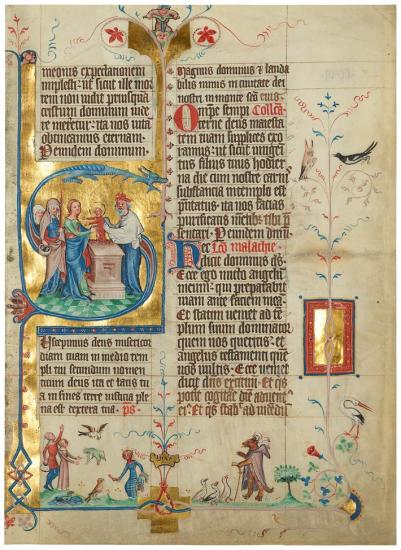
Single leaf from a Missal, in Latin
Illuminated by Meister Bertram von Minden
Purchased, 1958
Perhaps the doves carried by the Virgin Mary's attendant in the large scene inspired the illuminator to enliven the borders of this Missal leaf with avian themes. (The text is for the Feast of the Purification of the Virgin, celebrated on 2 February.) The young people hawking at the bottom left are fashionably dressed: the youth wears a red pourpoint with a dagged hem, a particularly tight chaperon, narrow belt, and open shoes. The women wear cotes hardy snug on the arms and upper body. The girl at the right has a tight red chaperon and, on top of that, a fanciful crown.
Wasp Waists and Stuffed Shirts
The second half of the fourteenth century was a bleak period in French history. The Black Plague, which first struck in 1348, was a recurring horror. As the Hundred Years' War dragged on, France suffered devastating defeats by the English. Following the Battle of Poitiers in 1356, King John II was captured and taken to London as a prisoner. Fashions changed little during this period.
Men's fashion was dominated by the pourpoint: a close-fitting doublet influenced by the military. With a short flaring skirt and a cinched waist, the pourpoint was padded at the chest and shoulders, giving its wearer a distinctive hourglass silhouette. Pouleines, long pointed shoes, and belts—slender, or the thick "Bohemian" girdle—worn low on the hips complimented the look.
The cote hardy—an outer garment for women—while retaining its voluminous skirt, got even tighter at the bodice, bosom, and sleeves. The resulting look paralleled that of men's fashion. Tippets, decorative strips of cloth hanging from the arms, remained popular. Both men and women continued to wear the chaperon (the hood with attached cape and tail).
